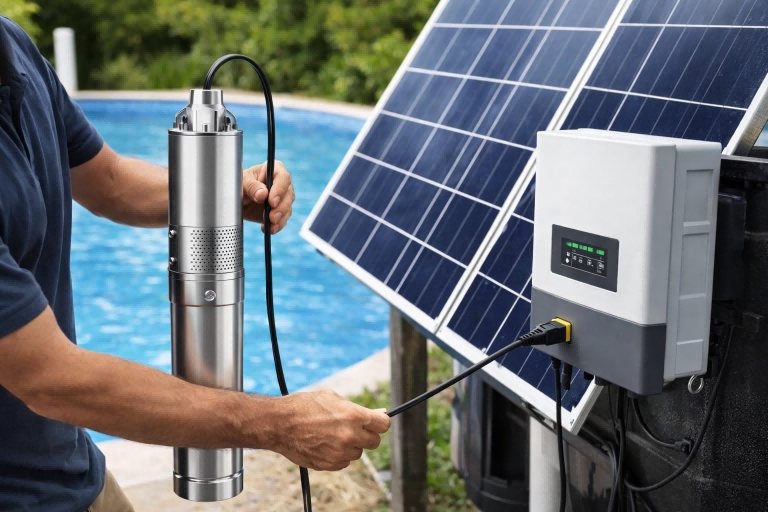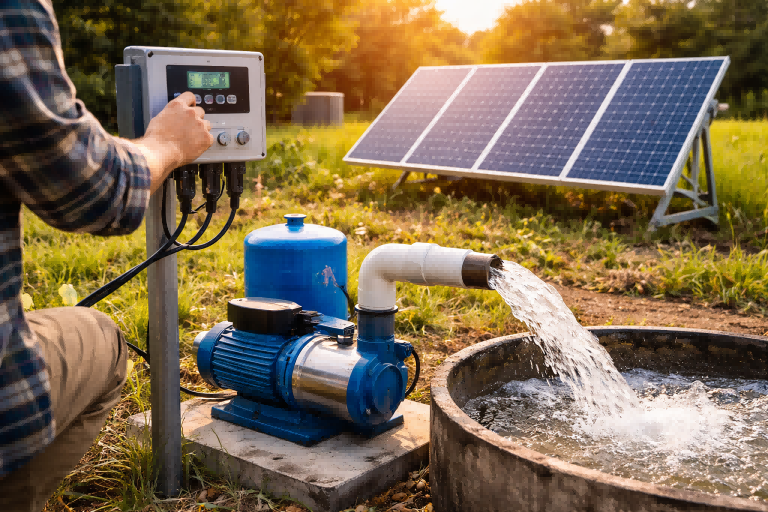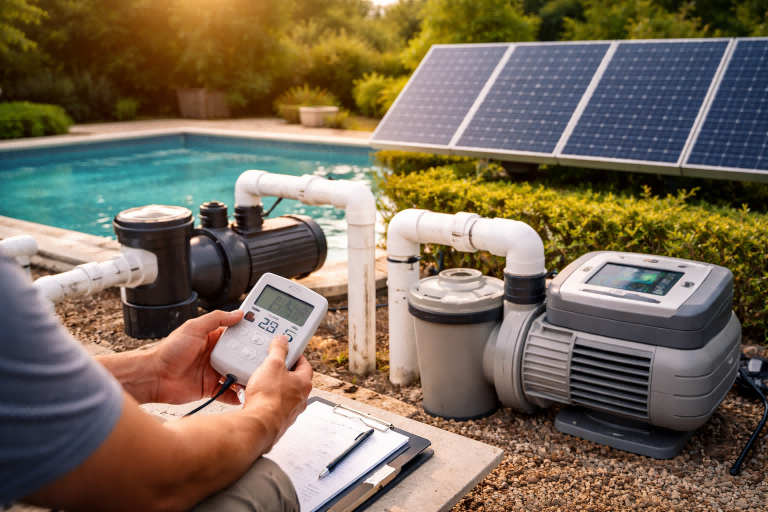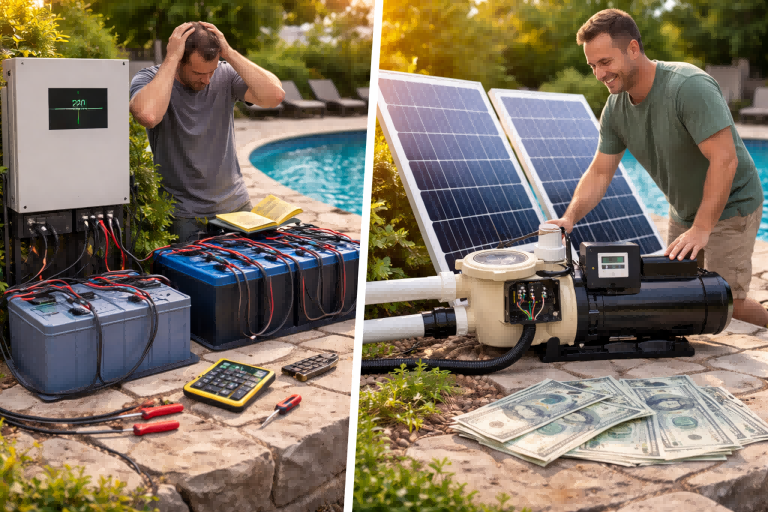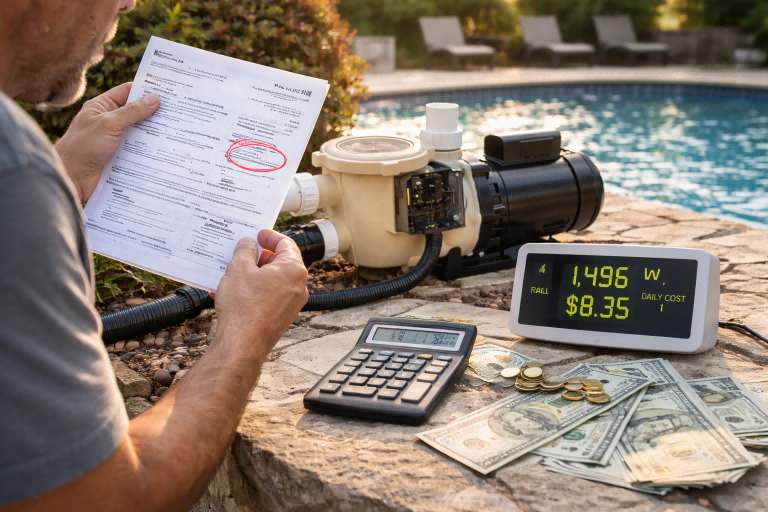Struggling with weak, unreliable water pressure?
This fluctuation can disrupt daily life and signal a problem with your water system.
A pump house provides the solution for consistent, strong flow.
A pump house shelters the equipment that draws water from a source, like a well, and pressurizes it for distribution. It contains a pump, a pressure tank, and a switch that work together to automatically maintain a steady water supply throughout your property, ensuring consistent pressure on demand.
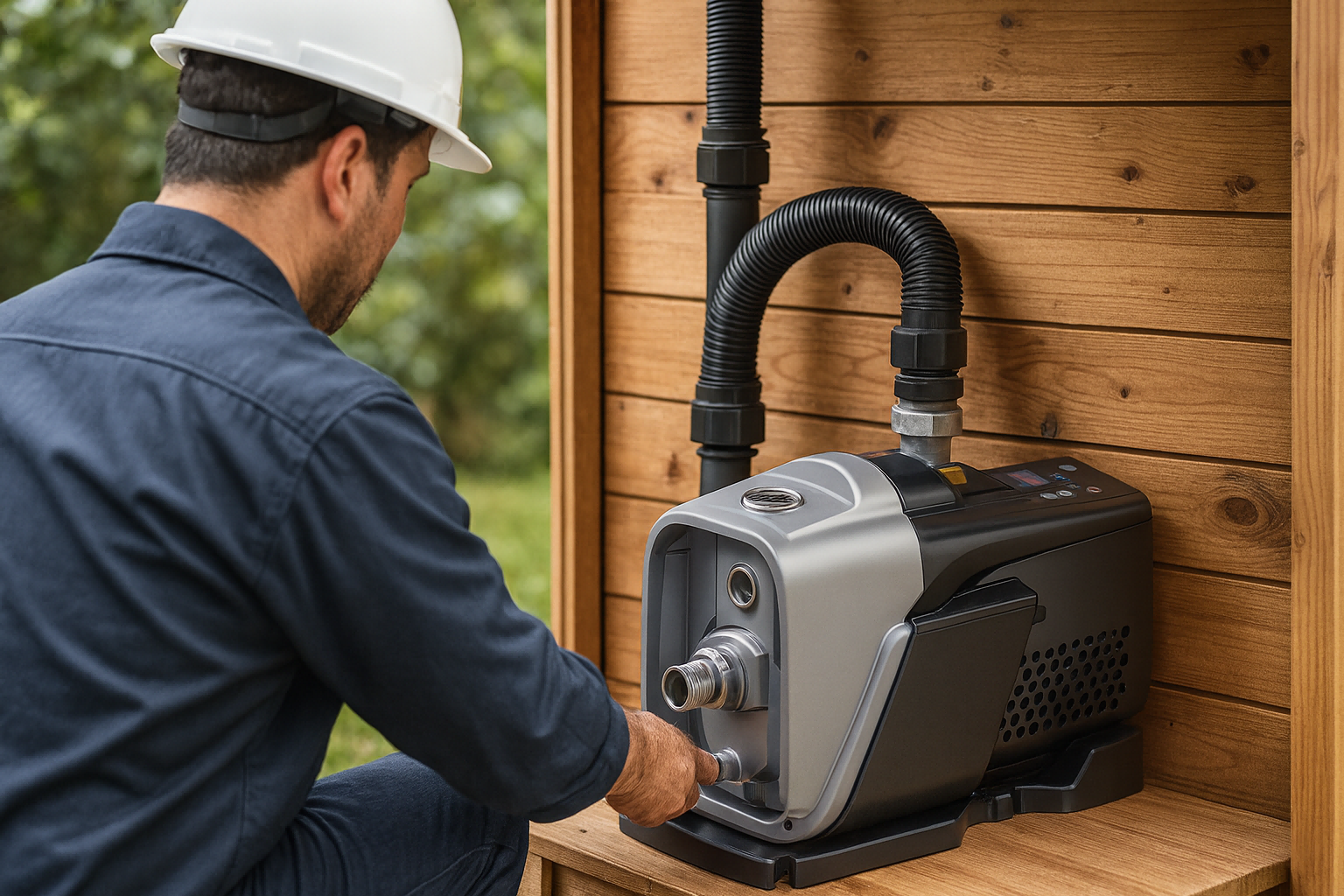
Understanding how these components work together is key to appreciating your water system's reliability.
This system is more than just a shelter; it's the control center for your entire water supply.
Let's explore the essential parts that make this possible and discover how they ensure water is always available when you need it.
What Are the Core Components Inside a Pump House?
Worried about what all the complex machinery in a pump house does?
It can seem like a confusing maze of pipes, tanks, and wires.
These components work as a simple, coordinated team to deliver water.
The core components are the water pump, which moves the water, a pressure tank to store it under pressure, and a pressure switch to control the pump. These three parts form the heart of the system, working in a continuous cycle to ensure you have water.
The Main Parts and Their Functions
Each component inside a pump house has a specific and vital job.
Without any one of these parts, the system would fail to deliver water reliably.
They are all interconnected, forming a chain of operations that starts at your water source and ends at your faucet.
Understanding each part individually helps to see the genius of the whole system.
- The Water Pump
The water pump is the workhorse of the entire operation.
Its single job is to move water from your source, such as a well or reservoir, into your plumbing system.
Pumps come in two main varieties: submersible and jet pumps.
A submersible pump is placed directly inside the water source, pushing water up to the surface.
A jet pump, on the other hand, is located on the surface, typically inside the pump house, and pulls water up from the source.
The choice between them often depends on the depth of your well.
- The Pressure Tank
The pressure tank acts as a small reservoir for pressurized water.
Inside the tank is an air bladder that becomes compressed as water is pumped in.
This compression is what creates the pressure in your water lines.
By storing a reserve of pressurized water, the tank reduces how often the pump needs to turn on and off.
This "cycling" reduction is crucial.
It saves energy by preventing the pump from starting every time a faucet is turned on for a short time.
It also significantly extends the lifespan of the pump motor by reducing wear and tear from frequent starts.
- The Pressure Switch
The pressure switch is the brain of the system.
It is a small electrical device that monitors the water pressure inside the pressure tank.
The switch has two set points: a cut-in pressure and a cut-out pressure.
When you use water, the pressure in the tank drops.
Once it hits the lower cut-in pressure (e.g., 40 PSI), the switch completes an electrical circuit, turning the pump on.
The pump then refills the tank.
When the pressure reaches the higher cut-out pressure (e.g., 60 PSI), the switch breaks the circuit, turning the pump off.
This automatic control ensures the system maintains pressure without any manual intervention.
Component Interaction Table
| Component | Primary Function | How It Interacts with Others |
|---|---|---|
| Water Pump | Moves water from source to tank. | Activated and deactivated by the pressure switch. Fills the pressure tank. |
| Pressure Tank | Stores water under pressure. | Receives water from the pump. Its pressure level is monitored by the switch. |
| Pressure Switch | Monitors pressure and controls the pump. | Senses pressure in the tank. Turns the pump on at low pressure and off at high pressure. |
How Does the Pumping Cycle Work?
Have you ever wondered what happens when you turn on a faucet?
It's not magic; it’s a precise, automated sequence happening in your pump house.
Understanding this cycle demystifies your home's water supply.
The pumping cycle begins when water use lowers pressure to the switch's 'cut-in' point, turning the pump on. The pump fills the tank until pressure hits the 'cut-out' point, shutting the pump off. The system then waits until the pressure drops again, creating a seamless, automated loop.
A Step-by-Step Breakdown of the Process
The entire water delivery process is a beautifully simple, repetitive cycle.
It's designed for efficiency and reliability, ensuring you have water exactly when you need it without a second thought.
Let's walk through the sequence of events, starting from the moment you demand water.
This cycle repeats countless times a day.
- Step 1: Demand for Water
The cycle starts with you.
You turn on a shower, flush a toilet, or start a washing machine.
This action opens a valve in your plumbing.
Pressurized water, stored in the pressure tank, immediately flows from the tank toward the open faucet.
This is why you get water instantly, even though the pump is not running at that moment.
- Step 2: Pressure Drops
As water leaves the pressure tank, the volume of water inside it decreases.
The compressed air in the tank's bladder expands to fill the space.
This expansion causes the overall pressure within the tank and the connected pipes to drop steadily.
The rate of the drop depends on how much water you are using.
A running garden hose will cause the pressure to fall much faster than a dripping faucet.
- Step 3: Pump Activation (Cut-In)
The pressure switch is constantly monitoring this pressure.
It has a pre-set low-pressure limit, known as the cut-in pressure.
A common cut-in setting is 40 PSI (pounds per square inch).
When the system pressure falls to this cut-in point, the switch closes an electrical contact.
This completes the circuit to the water pump, and the pump motor starts.
The workhorse is now active.
- Step 4: System Repressurization
With the pump running, two things happen at once.
First, water is sent directly to the fixture you are using, ensuring the flow does not weaken.
Second, the pump simultaneously refills the pressure tank.
As more water is forced into the tank, the air bladder is compressed again.
This causes the pressure in the entire system to begin rising.
- Step 5: Pump Deactivation (Cut-Out)
The pressure switch continues its monitoring job.
It also has a pre-set high-pressure limit, the cut-out pressure.
This is typically set about 20 PSI higher than the cut-in pressure, for example, at 60 PSI.
The pump continues to run and fill the tank until the system pressure climbs to this cut-out point.
Once it hits 60 PSI, the switch opens the electrical contact.
The circuit is broken, and the pump motor shuts off.
The cycle is now complete.
The pressure tank is full and ready for the next time you need water.
Why is a Pressure Tank So Important?
Is that big tank in your pump house really necessary?
It might look like it's just taking up space.
But without it, your pump and your power bill would suffer.
A pressure tank is vital because it stores pressurized water, reducing how often the pump must run. This prevents rapid on-off cycling, which saves energy, protects the pump motor from burnout, and ensures a smoother, more consistent water flow to your faucets.
The Unsung Hero of Water Pressure
The pressure tank's role is often misunderstood but is absolutely critical for a healthy, efficient water system.
It acts as a buffer, absorbing the small demands for water without needing to involve the pump every single time.
This function has several profound benefits for your system's longevity and performance.
Let's dive deeper into why this component is indispensable.
- Preventing Pump Burnout
The single most important job of the pressure tank is to prevent "short cycling."
Short cycling is when a pump turns on and off very rapidly in quick succession.
Imagine a system without a pressure tank.
The moment you crack open a faucet, the pressure would drop, and the pump would turn on.
The moment you close it, the pressure would spike, and the pump would turn off.
This constant starting and stopping creates immense heat and stress on the pump's motor and its electrical components.
A pressure tank allows you to draw a significant amount of water (the "drawdown") before the pump even needs to start.
This means the pump runs for longer, less frequent periods, allowing it to cool properly and operate far more efficiently.
- Enhancing Energy Efficiency
Every time a pump motor starts, it draws a large surge of electricity.
This inrush current is significantly higher than its normal running current.
By minimizing the number of starts, a pressure tank directly reduces your electricity consumption.
Instead of ten short bursts to wash your hands, the pump might not even turn on at all, simply using the reserve in the tank.
Over the course of a year, these energy savings can be substantial.
- Ensuring Smooth and Consistent Flow
A pressure tank acts as a shock absorber for your water system.
It smooths out the pressure fluctuations that occur when the pump starts and stops.
Without it, you would likely notice a significant drop in flow just before the pump kicks on and a surge just as it starts.
The tank's reserve of pressurized water bridges this gap, providing a much more stable and comfortable water pressure experience at the faucet.
Pressure Tank Performance Factors
| Factor | Description and Impact |
|---|---|
| Tank Size | A larger tank holds a larger volume of water (drawdown). This means the pump will cycle even less frequently, further extending pump life and improving efficiency. Size should be matched to pump capacity. |
| Pre-Charge Pressure | This is the air pressure inside the tank when it's empty of water. It must be set correctly, typically 2 PSI below the pump's cut-in pressure. Incorrect pre-charge leads to short cycling or a waterlogged tank. |
| Drawdown | This is the actual amount of water that can be drawn from the tank before the pump turns on. It is a function of tank volume, pre-charge pressure, and the system's cut-in/cut-out pressures. |
Do You Need to Heat a Pump House?
Concerned about your pump house during a cold winter?
Freezing temperatures can cause catastrophic damage to your water system.
Protecting your equipment is simpler than you might think.
Yes, a pump house in a cold climate must be heated or properly insulated to prevent water in the pipes, pump, and tank from freezing. Frozen water expands, which can crack pipes and destroy expensive equipment, leading to a total loss of water and costly repairs.
Protecting Your Investment from the Cold
Winter can be the biggest enemy of a water well system.
A single hard freeze can lead to thousands of dollars in damage and days without running water.
Therefore, providing some form of protection against freezing temperatures is not optional; it's a critical part of pump house design and maintenance.
There are several effective strategies to keep your system safe.
- The Dangers of Freezing
Water has a unique property: it expands by about 9% when it freezes.
This expansion exerts immense force on whatever is containing it.
Inside a pump house, this means that any trapped water in the pump casing, the pressure tank, or the connecting pipes will expand.
The force is easily strong enough to crack a cast iron pump body, rupture copper pipes, or even split the seams on a steel pressure tank.
The resulting damage is often irreparable, requiring complete replacement of the affected components.
The initial burst is just the beginning of the problem.
When the temperature rises and the ice thaws, you will have major leaks and water damage inside the structure.
- Insulation as the First Line of Defense
Proper insulation is the most important step in protecting your pump house.
All walls and the ceiling should be thoroughly insulated with high-quality material like fiberglass batts or rigid foam board.
Pay special attention to sealing any air gaps, cracks, or openings where cold air can infiltrate.
The goal is to create a sealed box that retains as much heat as possible.
The ground itself provides some geothermal warmth, and the pump motor generates a small amount of heat when it runs.
In many moderate climates, excellent insulation alone may be enough to keep the interior temperature above freezing.
Foam pipe sleeves should also be installed on all exposed plumbing.
- Adding a Supplemental Heat Source
For regions that experience deep or prolonged freezes, insulation alone is not enough.
A small, reliable heat source is necessary.
You do not need to keep the pump house warm, just above freezing (32°F or 0°C).
Several options exist:
- Thermostatically Controlled Space Heater: A small electric heater with a built-in thermostat is a popular choice. Set it to a low temperature (e.g., 40°F or 4°C) so it only turns on when truly needed, saving energy.
- Heat Lamp: A simple heat lamp (the kind used for warming animals) can provide enough radiant heat to protect a small, well-insulated space. Ensure it is securely mounted and kept far away from any flammable materials.
- Heat Tape: For pipes specifically, electric heat tape can be wrapped directly around them. The tape has a built-in thermostat that activates it only when temperatures drop near freezing.
Winterization Strategy Comparison
| Method | Best For | Pros | Cons |
|---|---|---|---|
| Insulation Only | Moderate climates with infrequent, light frosts. | Low cost, no energy use, passive protection. | Insufficient for hard freezes, relies on retaining ambient/ground heat. |
| Insulation + Space Heater | Cold climates with regular, hard freezes. | Very reliable, adjustable thermostat, heats entire space. | Uses electricity, potential fire hazard if not installed safely. |
| Insulation + Heat Tape | Protecting specific, vulnerable pipes. | Targets heat where needed, energy efficient. | Does not protect the pump or tank, only the pipes it's wrapped on. |
What are the Different Types of Well Pumps?
Unsure which pump is right for your well?
The depth of your water source is the single most important factor.
Using the wrong pump type will lead to inefficiency and failure.
The two main types are submersible pumps, which are placed down inside the well, and jet pumps, which are located at the surface. Submersible pumps are for deep wells (over 25 feet), while jet pumps are best for shallow wells (less than 25 feet deep).
Choosing the Right Pump for Your Well's Depth
The physics of moving water dictates which pump technology will be effective.
Pumps are much better at pushing water than they are at pulling or sucking it.
This fundamental difference is why well depth is the primary determining factor in pump selection.
Let's examine how each type works and where they excel.
- Submersible Pumps: The Deep Well Solution
As their name suggests, submersible pumps are designed to be completely submerged in water at the bottom of the well.
They are long, cylindrical units that contain both the pump and a sealed motor.
Instead of sucking water up, a submersible pump pushes water up the pipe to the surface.
Because pushing is far more efficient than pulling, these pumps can move water from very great depths, sometimes hundreds of feet.
Key Features of Submersible Pumps:
- High Efficiency: They use less energy to move water because they are only pushing it.
- Quiet Operation: Since the pump is deep underground, it is virtually silent at the surface.
- Self-Priming: Being submerged in water, they never need to be primed.
- Durability: They are cooled by the surrounding water, which can contribute to a longer service life.
- The main disadvantage is that repair or replacement is a major job, requiring the entire unit to be pulled up out of the well.
- Jet Pumps: The Shallow Well Workhorse
Jet pumps are located above ground, usually inside the pump house.
They work by creating suction to lift water from the well.
This is why they are limited to shallow applications.
Atmospheric pressure can only lift a column of water about 34 feet in a perfect vacuum; in a real-world pump, the practical limit is around 25 feet.
There are two variations of jet pumps:
- Shallow Well Jet Pump: Uses a single pipe to draw water from the source. It's the simplest design, used for wells 25 feet deep or less.
- Deep Well Jet Pump: Uses a two-pipe system. One pipe pushes water down to a jet ejector located in the well, which helps lift water up the second pipe. This design can be used for wells down to about 100 feet.
Key Features of Jet Pumps:
- Easy Access: Because the motor and pump are at the surface, they are much easier to access for maintenance and repair.
- Lower Initial Cost: Jet pumps are generally less expensive to purchase than submersible pumps.
- The main disadvantages are lower efficiency (especially the two-pipe deep well models) and louder operation since the motor is above ground. They also require priming before their first use.
Pump Type Comparison by Well Depth
| Pump Type | Max Well Depth | Location | Pros | Cons |
|---|---|---|---|---|
| Shallow Well Jet Pump | ~25 feet (8 meters) | Surface / Pump House | Easy maintenance, lower cost. | Noisy, less efficient, needs priming. |
| Deep Well Jet Pump | ~100 feet (30 meters) | Surface / Pump House | Easy maintenance, can be used for moderate depths. | Complex setup (2 pipes), less efficient than submersible. |
| Submersible Pump | 500+ feet (150+ meters) | Inside the well casing | Very efficient, quiet, self-priming, powerful. | Difficult and expensive to service or replace. |
How Do You Maintain a Pump House System?
Want to avoid a sudden and costly water system failure?
Neglecting your pump house is a gamble you don't want to lose.
Regular, simple preventive maintenance is the key to longevity.
Maintain your system by visually inspecting for leaks, listening for unusual noises, and checking the pressure tank's air charge annually. Also, keep the pump house clean and ensure any filters are changed regularly. This proactive approach prevents major breakdowns and ensures reliable operation.
A Simple Guide to Preventive Maintenance
A well-maintained pump house can provide decades of reliable service.
The maintenance tasks are not difficult or time-consuming, but they are incredibly important.
By performing a few checks on a regular basis, you can catch small problems before they become catastrophic failures.
Think of it as an annual health checkup for your water system.
- Annual Maintenance Checklist
Set aside an hour once a year to run through these simple steps.
The best time to do this is often in the spring, before the heavy water usage of summer, or in the fall, as you prepare for winter.
Step 1: Visual and Auditory Inspection
- Look for Leaks: Carefully inspect all pipes, fittings, and connections around the pump and tank. Look for drips, moisture, or signs of corrosion (like green or white buildup). A small drip can waste a surprising amount of water and indicate a failing seal.
- Listen to the Pump: Turn on a faucet and let the pump cycle on and off a few times. Listen for any new or unusual noises like grinding, squealing, or excessive rattling. These can be early warnings of bearing failure or debris in the pump.
- Check the Cycle Time: Time how long it takes for the pump to turn off after it starts. If this time becomes very short (e.g., under 30 seconds), it's a classic sign of a problem with your pressure tank.
Step 2: Check the Pressure Tank Pre-Charge
This is the single most important maintenance task.
An incorrect air charge is the number one cause of premature pump failure.
- Turn off the electrical power to the pump at the breaker.
- Open a faucet to drain all the water and pressure from the system. Leave the faucet open.
- Locate the air valve on the pressure tank (it looks like a tire valve, usually on top).
- Use a standard tire pressure gauge to check the air pressure.
- The pressure should be 2 PSI below your pump's cut-in pressure setting. For a 40/60 switch, the pre-charge should be 38 PSI.
- If the pressure is low, use a bicycle pump or air compressor to add air until it reaches the correct level. If water comes out of the air valve, the tank's internal bladder has failed, and the tank must be replaced.
Step 3: Clean and Tidy
- Clean the Area: Keep the pump house clean and free of dirt, leaves, and cobwebs. This prevents debris from being drawn into the pump motor's cooling fan.
- Change Filters: If your system has a sediment filter, follow the manufacturer's recommendations for changing the cartridge. A clogged filter will severely restrict water flow and pressure.
- Check Vents: Ensure any vents for the pump motor or for the structure itself are clear and not blocked by debris or snow.
Maintenance Task Schedule
| Task | Frequency | Why It's Important | Tools Needed |
|---|---|---|---|
| Visual/Auditory Inspection | Quarterly | Catches leaks and bearing noise early. | Eyes and ears. |
| Check Pressure Tank Pre-Charge | Annually | Prevents pump short cycling and burnout. | Power off, pressure gauge, air pump. |
| Change Sediment Filter | As needed (e.g., 3-6 months) | Maintains water pressure and quality. | Filter wrench. |
| Clean Pump House Area | Annually | Ensures proper airflow for motor cooling. | Broom, shop vac. |
Conclusion
A pump house reliably manages your water supply.
Its pump, tank, and switch work together in an automated cycle.
Proper maintenance ensures this vital system lasts for years.
FAQs
What is the use of a pump house?
A pump house protects essential water system components like the pump, pressure tank, and controls from weather, tampering, and freezing, ensuring a reliable and safe water supply.
Does a pump house need to be heated?
In climates with freezing temperatures, a pump house must be heated or well-insulated. This prevents water from freezing and bursting pipes or damaging the pump and tank.
What should be inside a pump house?
A standard pump house contains a water pump, a pressure tank, a pressure switch, and control wiring. It may also include a water filter, a pressure gauge, and a shut-off valve.
How big should a pump house be?
A pump house should be large enough to comfortably contain all components with adequate space around them for airflow and future maintenance. A typical size is 4x4 or 4x6 feet.
How does a well water pump work?
A well pump moves water from an underground well to your home. Submersible pumps push water up from inside the well, while jet pumps pull water from the surface.
What is the difference between a pump and a pump station?
A pump is a single device that moves water. A pump station (or pump house) is the complete system, including the pump, tank, controls, and protective shelter.
Is a pressure tank necessary?
Yes, a pressure tank is essential. It prevents the pump from starting and stopping too frequently, which saves energy, extends the pump's life, and provides consistent water pressure.
How do you set up a pump house?
Setup involves building a weatherproof, insulated structure on a concrete slab, installing the pump and tank, connecting all plumbing and electrical components, and ensuring it is protected from freezing.


